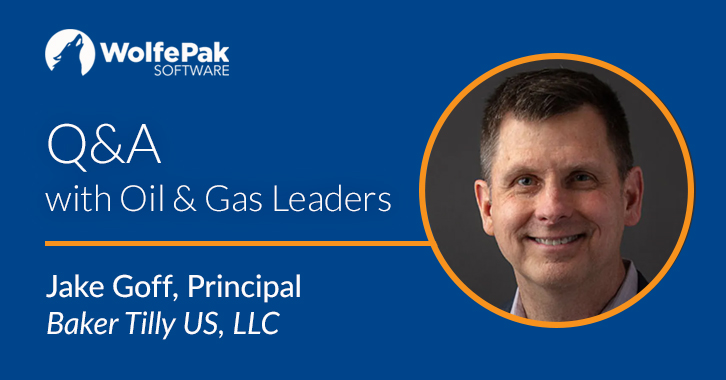
Jake Goff, principal at Baker Tilly US, talks with WolfePak about revenue automation and the strategic and financial benefits of production and accounting integration.
We’re back with another interview for our Q&A with Oil and Gas Leaders series. WolfePak spoke with Jake Goff, a principal with Baker Tilly US, LLP (Baker Tilly), a leading advisory, tax, and assurance firm.
Jake is with Baker Tilly’s client accounting services team, specializing in the upstream energy market, and has more than 30 years of experience in process and systems consulting, back-office outsourcing, accounting, and technology. He supports more than 100 independent oil and gas operators, investors, and mineral interest entities.
We spoke with Jake to discuss how oil and gas independents are facing today’s challenges of lower commodity prices and production rates, in addition to increased pressures from investors to improve efficiencies.
Q: Jake, can you give our readers an overview of your clients and the work you do daily?
Our team at Baker Tilly provides accounting and advisory services to the upstream energy market, supporting clients ranging from small and midsize independent operators to energy investment portfolios, funds, or privately-held O&G assets. We supplement existing operations or serve as the outsourced partner for accounting and back-office needs. Baker Tilly’s experienced O&G professionals help companies reduce costs and implement best practices across a variety of operational processes.
Q: Cutting costs is priority number one for our entire industry. How are you helping oil and gas companies rethink their processes and approach to work?
When demand is down and prices fluctuate, we focus on providing flexible staffing to ensure that our services best align with the individual client. This requires an agile approach to the scope and service requirements, as some clients need to add services and others need to reduce scope – it depends on their specific business needs. At the same time, there is a renewed level of detail to understand what hard costs can be reduced or eliminated.
As an outsourced partner, we’ve always provided remote services, but there are a number of situations where paper processes and manual document transfers still exist. Cutting down the reliance on these can eliminate costs and increase time savings and efficiencies. For example, even though revenue distribution has adopted ACH payments, email, and electronic information exchange for billing and revenue, there is still a large amount of printing and physical mailings required to cover all of the varied owner and vendor requirements.
Q: We’re in the business of automation, so we know the cost savings and operational efficiencies it brings. What level of automation do you see in the back office?
Automation is a broad term, but here are three categories:
- Task automation: Systems, integration, or robotic process automation (RPA) that can replace manual or routine work. This also improves accuracy and lowers costs.
- Process management automation: Workflow and process automation to manage and gain clear visibility and oversight into a business process.
- Decision automation: Analytics, data science, and artificial intelligence (AI) to determine insights into the business to assist in strategic or tactical decision-making.
Revenue management is one workflow in the upstream sector that is greatly improved with automation. Saving time and energy for the accounting team is one aspect, but having improved accuracy, reduced errors and rework, and optimizing tax and production have even larger impacts to cost savings.
The biggest challenges for this oil and gas accounting process are typically related to production and accounting system integration as well as interdependencies of deliverables to meet external accounting deadlines – production reporting, taxes, state and federal specialty filing – to name a few. On top of that, it can be difficult to juggle financial reporting and deadline management for receipt of deliverables if inputs are delayed or have errors.
Q: What are the benefits of automating revenue distribution?
Task automation for revenue distributions is common and there are widely-used systems and software in use daily. These systems calculate severance taxes, tax deductions, state and federal withholding, owner exemptions, and more. ACH payments, email, and third-party data distribution have become the norm and are simple and seamless to implement. There is almost no manual entry of revenue for most operators, and much less data is maintained outside of the system in spreadsheets. Today, it’s more about ensuring that you have strong integration points within these systems versus the source data in spreadsheets.
The sub-process still has room for improvement when it comes to production verification and accounting allocation. Typically, operators inherit or acquire a variety of operational systems in the field or often the system that is selected is not fully integrated with a marketing and allocation system that translates into the accounting system. Implementing a clear, repeatable production-accounting integration process with validation checkpoints allows you to resolve the issue in the production system then roll it forward again. This is a key to eliminating errors and creating a sustainable, efficient process.
Q: How is automation advancing work for owner relations and Division of Interest (DOI)?
Process management automation has made great strides for DOIs and owner relations. Both owners and operators are using electronic documents, making it easier to track requests and their status, manage backlogs, tasks, and assignments. There are more controls for revenue distribution, with internal workflows managing preliminary cycle status, approval gates, and final authorization, along with various steps for treasury disbursement controls. These controls are applied based on understanding the monthly inputs and threshold tolerances when reconciling these to the outputs of netted revenues, suspense changes, withholding, taxes, and distribution amounts.
CTA: Want to read another Q&A with an oil and gas leader? Read our discussion with WolfePak CTO Ryan Lailey.
